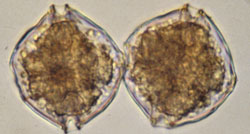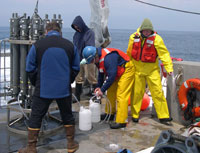You are here: Home › News & Features › Feature Story › New England Red Tide
Worst New England Harmful Algal Bloom in 30 Years

In 2005, the most severe bloom since 1972 of the microscopic alga, Alexandrium fundyense, spread from Maine to Massachusetts, resulting in extensive commercial and recreational shellfish harvesting closures to protect humans from paralytic shellfish poisoning (PSP). Alexandrium blooms are one of several algal bloom types often called red tides, but more correctly referred to as Harmful Algal Blooms (HABs). Such blooms occur periodically in the Gulf of Maine but rarely at the density and geographic extent witnessed during this event. The abnormally large bloom was possibly due to elevated rainfall and snowmelt in the Spring followed by two unusually late Nor'easters in May. The strong winds may have pushed the Alexandrium down the coast, while increased runoff likely fueled the outbreak by creating ideal conditions for growth.
State shellfish closures along the New England coast began as early as mid-May in 2005, disrupting the busiest period of the tourist season. In Massachusetts alone, direct economic impacts to the shellfish industry were estimated at $18 million. Areas were closed that had never been closed in previous outbreaks. A temporary closure of federal waters was declared on June 14, 2005, based on the transport of toxic cells offshore.
On September 9, 2005, NOAA Fisheries Service partially re-opened the temporarily closed Federal waters for harvesting of some bivalve mollusks. States had reopened many areas to shellfish harvesting by Autumn 2005, but some areas remain closed almost a year after the bloom began due to sustained shellfish toxicity. It is always important to check state and federal websites for the latest information on shellfish closures.
For more information on the 2005 event, consult Woods Hole Oceanographic Institution's Northeast PSP webpage.
Collaborative Response to the 2005 Event
The 2005 New England Harmful Algal Bloom was first detected offshore by WHOI researchers on a research cruise in the Gulf of Maine and Massachusetts Bay as part of a project for the NSF/NIEHS-supported Woods Hole Center for Oceans and Human Health (COHH). NOAA responded to the New England Harmful Algal Bloom by providing emergency funding to pay for new and expanded sampling of the toxic algae in Massachusetts Bay. This emergency funding through NOAA's Ocean Service National Centers for Coastal Ocean Science/ Center for Sponsored Coastal Ocean Research's (CSCOR) Harmful Algal Bloom Event Response Program allowed monitoring of the extent and movement of the bloom in order to provide managers with early warnings of shellfish toxicity to protect public health in the region. Initial funding of $16,300 was awarded on May 23, 2005 for a series of cruises to assess the extent of the bloom in Massachusetts coastal waters. Expansion of shellfish closures to Buzzards Bay, Nantucket Island, and Martha's Vineyard raised the concern that Alexandrium could move into southern New England and New York waters, resulting in additional shellfish closures. Supplemental funding amounts of $2,300 and $12,000 were approved on May 27, 2005 and June 8, 2005, respectively, to support cruises that continue to assess the spread of the bloom. After the declaration of the temporary closure in federal waters on June 14, 2005 some monitoring cruises were extended into federal waters. Information about Alexandrium abundance is of great value to state coastal managers because it allows them to focus their sampling efforts on new areas and decrease sampling efforts in areas that were already closed and which are surrounded by waters with very high Alexandrium concentrations. Information about cell densities allows managers to focus toxin sampling on areas where shellfish openings will be most likely to be possible.
Organizations involved in the emergency response to this HAB event include the Woods Hole Oceanographic Institution (WHOI), Massachusetts Division of Marine Fisheries, Massachusetts Water Resources Authority (MWRA), University of Massachusetts - Dartmouth Center for Coastal Studies in Provincetown, and the Cooperative Institute for Climate and Ocean Research. At times, four research vessels supported and staffed by WHOI and these groups were in the water simultaneously sampling this bloom. Ancillary data from moorings was provided by the Gulf of Maine Ocean Observing System and the U.S. Geological Survey's Woods Hole instrumented mooring near the MWRA outfall.
CSCOR Funds Follow-Up Research to the 2005 Event

NOAA awarded an additional $540,000 to WHOI to sustain monitoring throughout the 2005 bloom period and to support post-bloom research (see press release) to enhance prediction and response for 2006 and future years. The post-bloom research in 2005 addressed two main objectives geared toward improving future mitigation efforts:
- The comprehensive dataset was used to “hindcast” the bloom to clarify the causes. This has improved bloom forecasts.
- The high abundance and broad extent of the 2005 event suggested potential for newly deposited cysts (or seeds) on the seafloor in areas where cyst beds previously did not exist. The new cyst beds were mapped after the 2005 bloom, and the surveys did not show that many new cysts were deposited in Massachusetts Bay. However, there were still many more cysts off western Maine than documented in the 1997 ECOHAB funded survey. New cyst maps after each bloom season since 2005 will improve bloom predictions for the following year (see below).
NOAA Research Aids New England Red Tide Prediction and Response
- CSCOR Funds Knowledge Base to Aid New England Red Tide Prediction and Response
- Cyst Maps Improve Alexandrium Bloom Predictions
- 2006 New England Red Tide Response
Press Releases About this Event
- NOAA Press Release July 14, 2005
- NOAA Press Release June 23, 2005
- NOAA Press Release June 16, 2005
- NOAA Press Release June 14, 2005
- NOAA Press Release June 9, 2005
- Article on NOAA News June 9, 2005
Go to the current Alexandrium bloom event page

